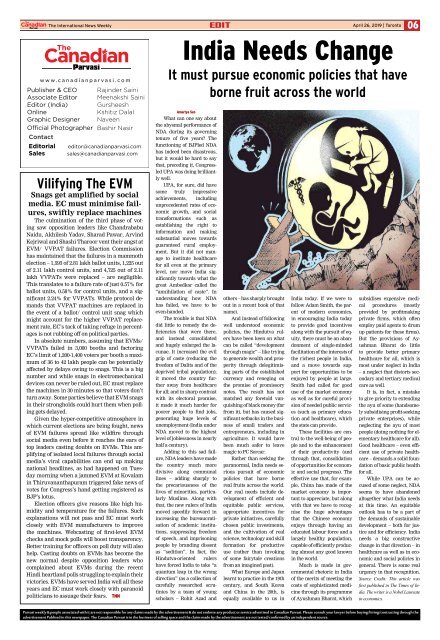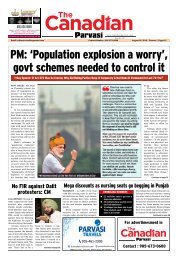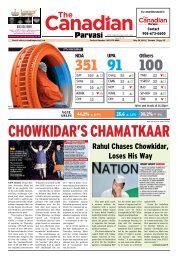Create successful ePaper yourself
Turn your PDF publications into a flip-book with our unique Google optimized e-Paper software.
<strong>The</strong> International News Weekly Edit<br />
06<br />
April 26, 2019 | Toronto<br />
<strong>The</strong><br />
w w w . canadianparv asi. c o m<br />
Publisher & CEO<br />
Associate Editor<br />
Editor (India)<br />
Online<br />
Graphic Designer<br />
Official Photographer<br />
Contact<br />
Editorial<br />
Sales<br />
Rajinder Saini<br />
Meenakshi Saini<br />
Gursheesh<br />
Kshitiz Dalal<br />
Naveen<br />
Bashir Nasir<br />
editor@canadianparvasi.com<br />
sales@canadianparvasi.com<br />
Vilifying <strong>The</strong> EVM<br />
Snags get amplified by social<br />
media. EC must minimise failures,<br />
swiftly replace machines<br />
<strong>The</strong> culmination of the third phase of voting<br />
saw opposition leaders like Chandrababu<br />
Naidu, Akhilesh Yadav, Sharad Pawar, Arvind<br />
Kejriwal and Shashi Tharoor vent their angst at<br />
EVM/ VVPAT failures. Election Commission<br />
has maintained that the failures in a mammoth<br />
election – 1,593 of 2.81 lakh ballot units, 1,225 out<br />
of 2.11 lakh control units, and 4,725 out of 2.11<br />
lakh VVPATs were replaced – are negligible.<br />
This translates to a failure rate of just 0.57% for<br />
ballot units, 0.58% for control units, and a significant<br />
2.24% for VVPATs. While protocol demands<br />
that VVPAT machines are replaced in<br />
the event of a ballot/ control unit snag which<br />
might account for the higher VVPAT replacement<br />
rate, EC’s tack of taking refuge in percentages<br />
is not rubbing off on political parties.<br />
In absolute numbers, assuming that EVMs/<br />
VVPATs failed in 3,000 booths and factoring<br />
EC’s limit of 1,200-1,400 voters per booth a maximum<br />
of 36 to 42 lakh people can be potentially<br />
affected by delays owing to snags. This is a big<br />
number and while snags in electromechanical<br />
devices can never be ruled out, EC must replace<br />
the machines in 30 minutes so that voters don’t<br />
turn away. Some parties believe that EVM snags<br />
in their strongholds could hurt them when polling<br />
gets delayed.<br />
Given the hyper-competitive atmosphere in<br />
which current elections are being fought, news<br />
of EVM failures spread like wildfire through<br />
social media even before it reaches the ears of<br />
top leaders casting doubts on EVMs. This amplifying<br />
of isolated local failures through social<br />
media’s viral capabilities can end up making<br />
national headlines, as had happened on Tuesday<br />
morning when a jammed EVM at Kovalam<br />
in Thiruvananthapuram triggered fake news of<br />
votes for Congress’s hand getting registered as<br />
BJP’s lotus.<br />
Election officers give reasons like high humidity<br />
and temperature for the failures. Such<br />
explanations will not pass and EC must work<br />
closely with EVM manufacturers to improve<br />
the machines. Webcasting of first-level EVM<br />
checks and mock polls will boost transparency.<br />
Better training for officers on poll duty will also<br />
help. Casting doubts on EVMs has become the<br />
new normal despite opposition leaders who<br />
complained about EVMs during the recent<br />
Hindi heartland polls struggling to explain their<br />
victories. EVMs have served India well all these<br />
years and EC must work closely with paranoid<br />
politicians to assuage their fears. TNN<br />
India Needs Change<br />
It must pursue economic policies that have<br />
borne fruit across the world<br />
Amartya Sen<br />
What can one say about<br />
the abysmal performance of<br />
NDA during its governing<br />
tenure of five years? <strong>The</strong><br />
functioning of BJPled NDA<br />
has indeed been disastrous,<br />
but it would be hard to say<br />
that, preceding it, Congressled<br />
UPA was doing brilliantly<br />
well.<br />
UPA, for sure, did have<br />
some truly impressive<br />
achievements, including<br />
unprecedented rates of economic<br />
growth, and social<br />
transformations such as<br />
establishing the right to<br />
information and making<br />
substantial moves towards<br />
guaranteed rural employment.<br />
But it did not manage<br />
to institute healthcare<br />
for all even at the primary<br />
level, nor move India significantly<br />
towards what the<br />
great Ambedkar called the<br />
“annihilation of caste”. In<br />
understanding how NDA<br />
has failed, we have to be<br />
even-handed.<br />
<strong>The</strong> trouble is that NDA<br />
did little to remedy the deficiencies<br />
that were there,<br />
and instead consolidated<br />
and hugely enlarged the lacunae.<br />
It increased the evil<br />
grip of caste (reducing the<br />
freedom of Dalits and of the<br />
deprived tribal population);<br />
it moved the country further<br />
away from healthcare<br />
for all; and in sharp contrast<br />
with its electoral promise,<br />
it made it much harder for<br />
poorer people to find jobs,<br />
generating huge levels of<br />
unemployment (India under<br />
NDA moved to the highest<br />
level of joblessness in nearly<br />
half a century).<br />
Adding to this sad failure,<br />
NDA leaders have made<br />
the country much more<br />
divisive along communal<br />
lines – adding sharply to<br />
the precariousness of the<br />
lives of minorities, particularly<br />
Muslims. Along with<br />
that, the new rulers of India<br />
moved speedily forward in<br />
increasing the bureaucratisation<br />
of academic institutions,<br />
suppressing freedom<br />
of speech, and imprisoning<br />
people by branding dissent<br />
as “sedition”. In fact, the<br />
Hindutva-oriented rulers<br />
have forced India to take “a<br />
quantum leap in the wrong<br />
direction” (as a collection of<br />
carefully researched scrutinies<br />
by a team of young<br />
scholars – Rohit Azad and<br />
others – has sharply brought<br />
out in a recent book of that<br />
name).<br />
And instead of following<br />
well understood economic<br />
policies, the Hindutva rulers<br />
have been keen on what<br />
can be called “development<br />
through magic” – like trying<br />
to generate wealth and prosperity<br />
through delegitimising<br />
parts of the established<br />
currency and reneging on<br />
the promise of promissory<br />
notes. <strong>The</strong> result has not<br />
matched any foretold vanquishing<br />
of black money (far<br />
from it), but has caused significant<br />
setbacks in the business<br />
of small traders and<br />
entrepreneurs, including in<br />
agriculture. It would have<br />
been much safer to leave<br />
magic to PC Sorcar.<br />
Rather than seeking the<br />
paranormal, India needs serious<br />
pursuit of economic<br />
policies that have borne<br />
real fruits across the world.<br />
Our real needs include development<br />
of efficient and<br />
equitable public services,<br />
appropriate incentives for<br />
private initiatives, carefully<br />
chosen public investments,<br />
and the cultivation of real<br />
science, technology and skill<br />
formation for productive<br />
use (rather than invoking<br />
of some fairytale creations<br />
from an imagined past).<br />
What Europe and Japan<br />
learnt to practice in the 19th<br />
century, and South Korea<br />
and China in the 20th, is<br />
equally available to us in<br />
India today. If we were to<br />
follow Adam Smith, the parent<br />
of modern economics,<br />
in encouraging India today<br />
to provide good incentives<br />
along with the pursuit of equity,<br />
there must be an abandonment<br />
of single-minded<br />
facilitation of the interests of<br />
the richest people in India,<br />
and a move towards support<br />
for opportunities to be<br />
enjoyed by people at large.<br />
Smith had called for good<br />
use of the market economy<br />
as well as for careful provision<br />
of needed public services<br />
(such as primary education<br />
and healthcare), which<br />
the state can provide.<br />
<strong>The</strong>se facilities are central<br />
to the well-being of people<br />
and to the enhancement<br />
of their productivity (and<br />
through that, consolidation<br />
of opportunities for economic<br />
and social progress). <strong>The</strong><br />
effective use that, for example,<br />
China has made of the<br />
market economy is important<br />
to appreciate, but along<br />
with that we have to recognise<br />
the huge advantages<br />
that the Chinese economy<br />
enjoys through having an<br />
educated labour force and a<br />
largely healthy population,<br />
capable of efficiently producing<br />
almost any good known<br />
in the world.<br />
Much is made in governmental<br />
rhetoric in India<br />
of the merits of meeting the<br />
costs of sophisticated medicine<br />
through its programme<br />
of Ayushman Bharat, which<br />
subsidises expensive medical<br />
procedures (mostly<br />
provided by profitmaking<br />
private firms, which often<br />
employ paid agents to drum<br />
up patients for these firms).<br />
But the provisions of Ayushman<br />
Bharat do little<br />
to provide better primary<br />
healthcare for all, which is<br />
most under neglect in India<br />
– a neglect that distorts secondary<br />
and tertiary medical<br />
care as well.<br />
It is, in fact, a mistake<br />
to give priority to extending<br />
the ayu of some (handsomely<br />
subsidising profit-seeking<br />
private enterprises), while<br />
neglecting the ayu of most<br />
people (doing nothing for elementary<br />
healthcare for all).<br />
Good healthcare – even efficient<br />
use of private healthcare<br />
– demands a solid foundation<br />
of basic public health<br />
for all.<br />
While UPA can be accused<br />
of some neglect, NDA<br />
seems to have abandoned<br />
altogether what India needs<br />
at this time. An equitable<br />
outlook has to be a part of<br />
the demands of sustainable<br />
development – both for justice<br />
and for efficiency. India<br />
needs a big constructive<br />
change in that direction – in<br />
healthcare as well as in economic<br />
and social policies in<br />
general. <strong>The</strong>re is some real<br />
urgency in that recognition.<br />
Source Credit: This article was<br />
first published in <strong>The</strong> Times of India.<br />
<strong>The</strong> writer is a Nobel Laureate<br />
in economics.<br />
<strong>Parvasi</strong> weekly & people associated with it are not responsible for any claims made by the advertisement & do not endorse any product or service advertised in <strong>Canadian</strong> <strong>Parvasi</strong>. Please consult your lawyer before buying/hiring/contracting through the<br />
advertisement Publised in this newspaper. <strong>The</strong> <strong>Canadian</strong> <strong>Parvasi</strong> is in the business of selling space and the clains made by the advertisement are not tested/confirmed by an independent source.
















